Apple iPhone 4S: Thoroughly Reviewed
by Anand Lal Shimpi & Brian Klug on October 31, 2011 7:45 PM EST- Posted in
- Smartphones
- Apple
- Mobile
- iPhone
- iPhone 4S
Faster Throughput on WCDMA
Fixing unintended attenuation is only one part of what’s new however, the other part of the story is faster cellular connectivity for users on WCDMA/UMTS carriers. Users who are using the 4S on CDMA (like Sprint or Verizon) won’t see a performance difference since this is still the same EVDO Rev.A.
The iPhone 4 used an Intel/Infineon X-Gold 618 which supported HSDPA 7.2 and HSUPA 5.76. The MDM6610 inside the 4S supports HSDPA 14.4 and HSUPA 5.76, alongside a number of 3GPP Rel.7 features which are colloquially known as HSPA+. I talked about this extensively in another piece when there was some confusion about whether or not the 4S is HSPA+ - which it is.
| iPhone Cellular Speeds | ||||
| Property | iPhone 3G/3GS | iPhone 4 (GSM/UMTS) | iPhone 4 (CDMA) | iPhone 4S |
| Baseband | Infineon X-Gold 608 | Infineon X-Gold 618 | Qualcomm MDM6600 | Qualcomm MDM6610 |
| HSDPA | Cat.8 - 7.2 Mbps | Cat.8 - 7.2 Mbps | N/A | Cat.10 - 14.4 Mbps |
| HSUPA | None - 384 Kbps WCDMA only | Cat.6 - 5.76 Mbps | N/A | Cat.6 - 5.76 Mbps |
| EVDO | N/A | N/A | 1x/EVDO Rev.A | 1x/EVDO Rev.A |
The previous X-Gold 618 baseband was a nice improvement over the iPhone 3G/3GS’ X-Gold 608, which lacked HSUPA, but in a world where most WCDMA carriers are at least running HSDPA 14.4, it’s nice to finally have an iPhone with something faster than HSDPA 7.2. I’ve done lots of testing inside my Tucson, AZ market (which is “4G” HSPA+ on AT&T’s coverage viewer) with both the 4 and the 4S, and have built a very good feel for the 4’s performance. As a reminder, if you’re in the USA, those dark blue areas represent HSPA+ coverage areas with AT&T’s upgraded backhaul. In practice these are at least HSDPA 14.4.

Left: iPhone 4 Limited to ~6.1 Mbps down, Right: iPhone 4S (same location) hitting ~9 Mbps
With line of sight to an AT&T NodeB inside my HSPA+ market I’m used to seeing a maximum downstream throughput on the iPhone 4 of almost exactly ~6.1 Mbps, which is about right for the 4’s HSDPA 7.2 maximum when you include overhead. The nice straight line in that result should clue you in that downstream throughput on the 4 was being gated by the baseband. On the 4S, in this same location, I’ve been able to get 9.9 Mbps when the cell isn’t loaded at night (I didn't grab a screenshot of that one, for some reason). It’s nice to finally not be gated by the baseband anymore on an iDevice. Having a faster baseband is part of the reason the 4S’s cellular performance is much better, the other half is receive diversity which helps the 4S push these high throughput rates, and also dramatically improve performance at cell edge.
I did some drive testing with the 4 and 4S side by side and targeted areas that I know have pretty poor signal strength. The 4S is shown in yellow, the 4 in blue.
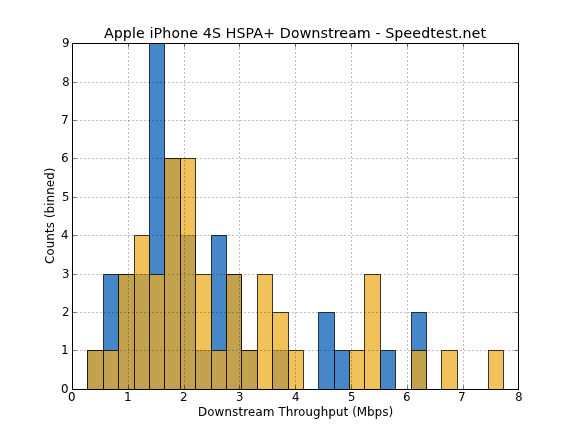
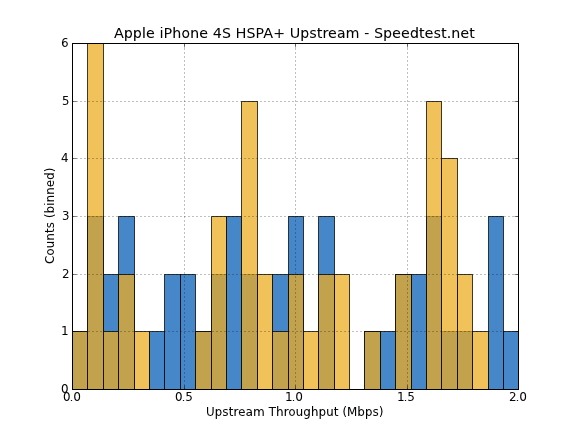
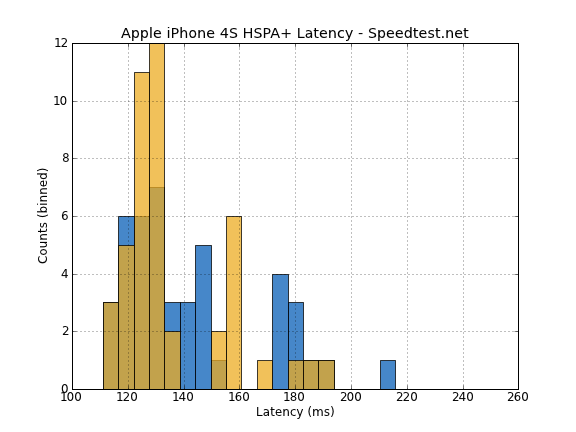
You can see how downstream throughput gets a nice shift up, and the average changes as well, from 2.28 Mbps on the 4 to 2.72 Mbps on the 4S. The maximum in this sample increases from 6.25 to 7.62 Mbps as well. It isn’t a huge shift, but subjectively I’ve noticed the 4S going a lot faster in areas that previously were difficult for the 4.
We’ve also run the usual set of standalone tests on the 4S on AT&T in my market of Tucson, AZ, in Anand’s market of Raleigh, NC, and on Verizon in Raleigh, NC. Though we don’t have a Sprint 4S yet, we hope to do a more serious 4S carrier comparison here in the US when we get one. First up is AT&T which is of course HSPA+ in both of our testing markets.
AT&T HSPA+
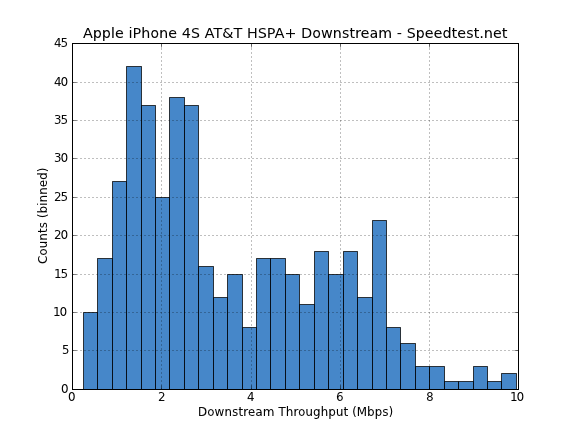
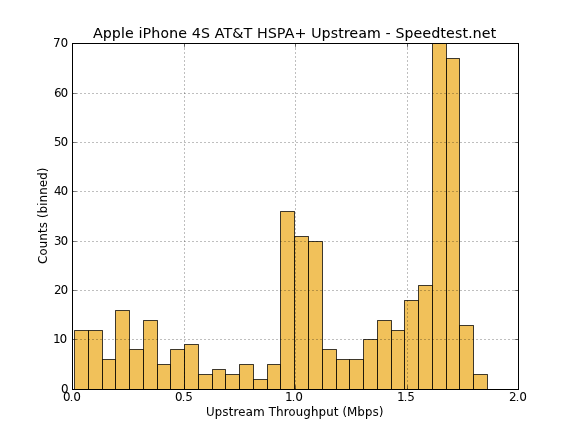

Verizon EVDO
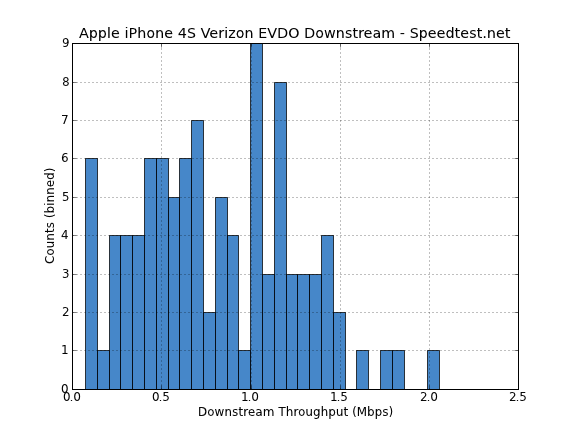
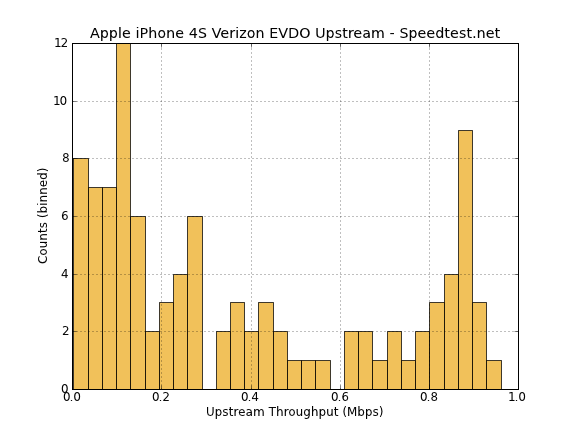

| iPhone 4S Speedtest Comparison | ||||||
| Carrier | AT&T | Verizon | ||||
| Avg | Max | Min | Avg | Max | Min | |
| Downstream (Mbps) | 3.53 | 9.94 | 0.24 | 0.82 | 2.05 | 0.07 |
| Upstream (Mbps) | 1.17 | 1.86 | 0.009 | 0.38 | 0.96 | 0.003 |
| Latency (ms) | 137 | 784 | 95 | 177 | 1383 | 104 |
| Total Tests | 457 | 150 | ||||
| Air Interface |
HSPA+ (HSDPA 14.4/HSUPA 5.76) |
EVDO Rev.A | ||||
For the CDMA carriers, the 4S shouldn’t (and doesn’t) bring any huge improvement to data throughput because the CDMA 4 had both receive diversity and MDM66x0. For users on GSM/UMTS, however, the 4S does make a difference again thanks to the inclusion of those two new features.
One of the things I noticed was absent on the CDMA iPhone 4 was the 3G toggle. It does indeed make some sense to not include this in a CDMA 1x/EVDO scenario since power draw is about the same between the two air interfaces, however, the absence of this toggle has carried over to the 4S regardless of whether the phone is activated on a CDMA2000 or UMTS/GSM network. That’s right, you can go under Settings -> General -> Network, and there’s no longer any 3G Data toggle which you can disable and fall onto EDGE (2G) with now.
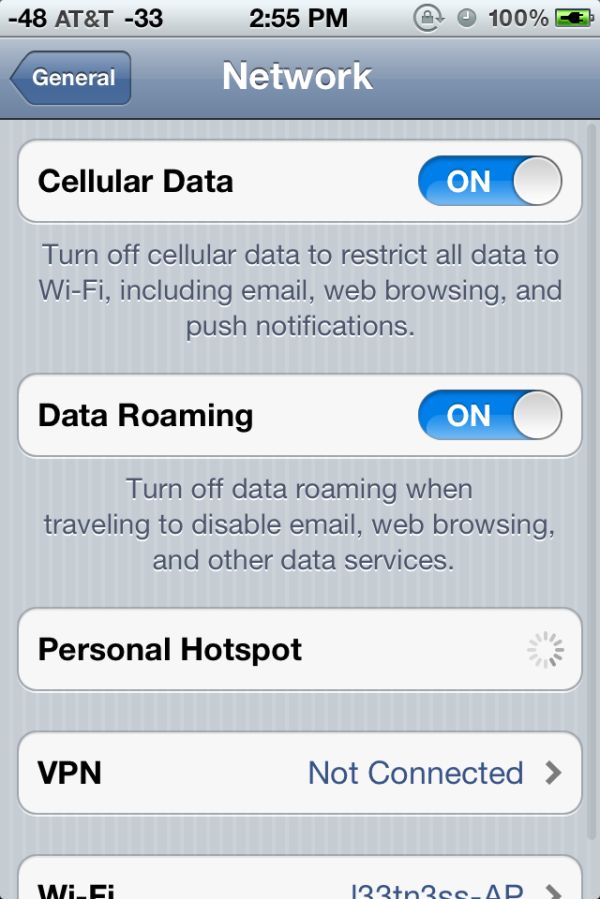
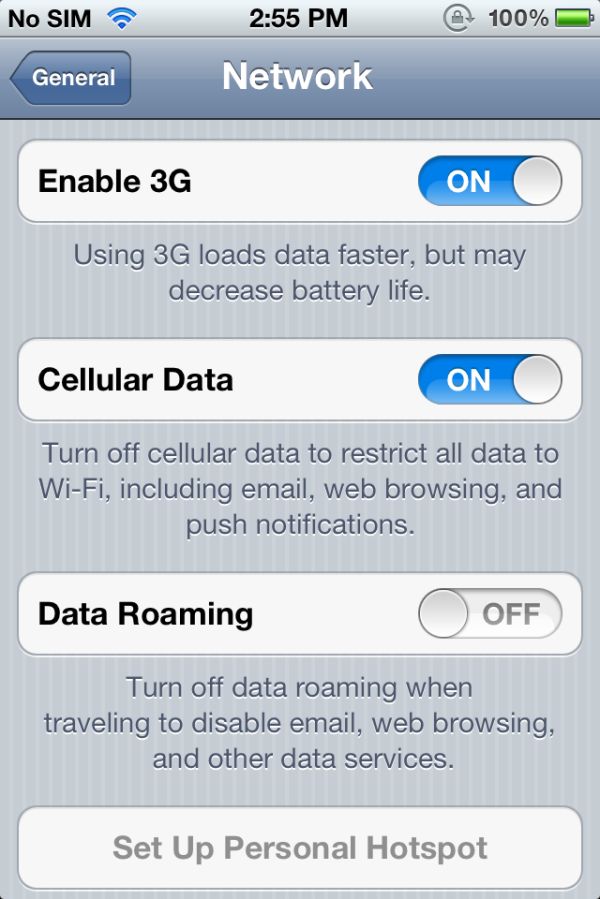
Left: iPhone 4S (no 3G toggle), Right: iPhone 4 (3G toggle)
It’s likely that this is absent to accommodate the multi-mode nature of the 4S (and thus the lowest common denominator CDMA mode), however the absence of this toggle makes getting connected in congested areas more difficult. In some markets, (I’m looking at you, AT&T in Las Vegas), EDGE is often the only way to get any connectivity, even without a major convention going on. Not having that 3G toggle makes manually selecting that less-used but more reliable connection impossible now, to say nothing of the potential battery savings that this would afford (and that we sadly can’t test now).
There’s one last tangential question about HSPA+ on the 4S, specifically on AT&T. I’ve left this to the end since it doesn’t impact non-US 4S users, but the last question is whether the 4S is actually on HSPA+. For a while, I was concerned that AT&T would continue using the wap.cingular APN on the 4S which seems shaped to around 7.2 Mbps HSDPA. I’m glad to report that AT&T hasn’t continued using wap.cingular on its 4S data plans, instead using “phone” which is a newer APN that allows for HSPA+ (above 7.2 Mbps) rates. You can check this yourself under PDP Context Info on the 4S in field test.


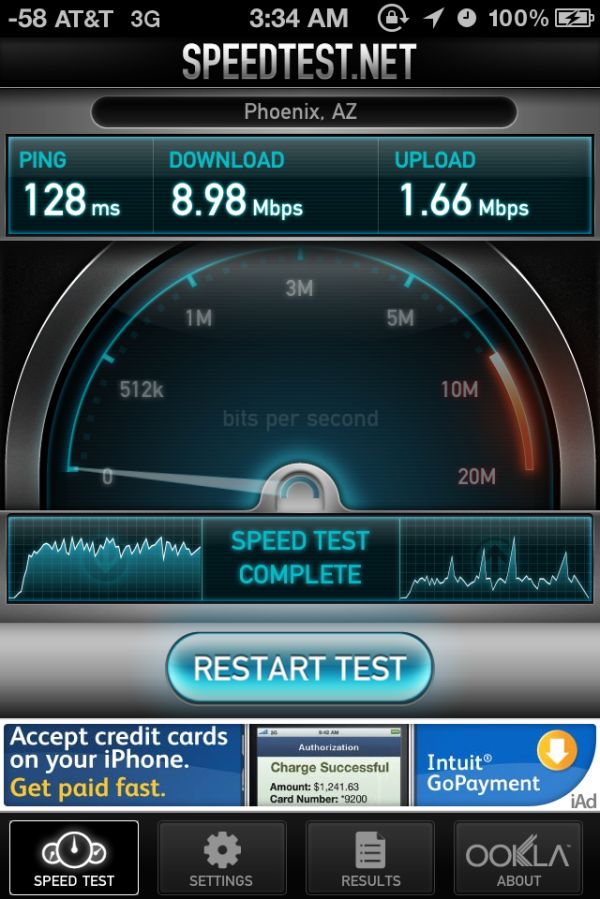
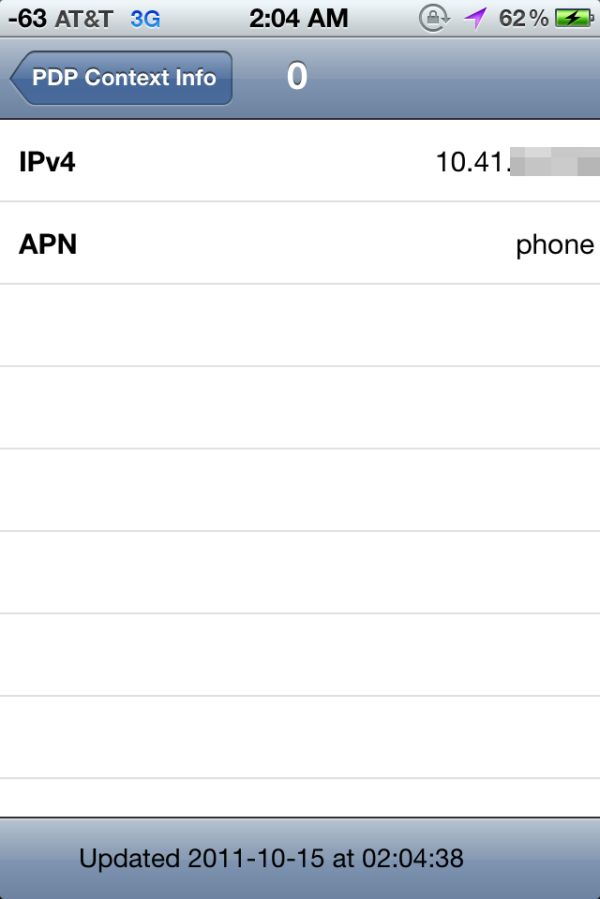








199 Comments
View All Comments
ados_cz - Tuesday, November 1, 2011 - link
I have the 4S now and the problem is gone but once my girlfriend comes with her 4, I will make a video and post it to prove you wrong. People have no problems only in areas where signal is really strong. Why would I possibly want to lie?wonderfield - Tuesday, November 1, 2011 - link
What's of concern here is not whether the issue (signal loss) can be demonstrated but whether the phone is, in Brian's/Anand's words, "usable" with the defect or not. It's certainly possible for the GSM iPhone 4 to be rendered unusable in a low signal strength area with a natural, right-handed grip just as it can be rendered unusable with a death grip. That's not to say the phone will be unusable in most scenarios, however, because in most scenarios the phone should function properly. There are certainly edge cases, and the issue is more significant for those who're left-handed and for those who live/work in very poor coverage areas (where it can become an issue), but, again, that's not the typical use case. It's why I categorize Brian's claim that the GSM 4 is not usable without a case as being disingenuous.Realistically, you don't need a "really strong" signal to have not have any problems with the phone, you only need a signal great enough to overcome any attenuation introduced by making contact with the antenna. The extent of the attenuation, as demonstrated in another Anandtech article to which you might refer, is not as significant as portrayed by some media outlets.
ados_cz - Tuesday, November 1, 2011 - link
As far as the need for good signal went I needed to use the case all the time otherwise I would always have to hold the phone in unnatural way. iPhone 4/S is a really beautiful piece of hardware and It was really upseting that I had to use the case and spoil the desing. My close friend living just 15 miles next to me in Perth does not use the case and when he does not care to not to hold the phone in sensitive area, the call drops. It happend to me with him on the phone on few occasions. Few of my friends at uni need to use the case for iPhone 4 as well. The problem was not overstated. Either learn to hold the phone unnaturaly avoiding joining those two critical antenna strips or use a case. I opted for a case. My friend in the London got on well without case, but he learned to hold it by the to when calling. Anyway, I am glad that I have the 4S now and I think my girlfriend does not mind the case on her (former mine) iPhone 4. It so well made piece of hardware and so affordable here in Britain. You are being ripped off in US. Check the deals for iPhones on www.three.co.uk I got mine iPhone 4 for 69 pounds 5 months ago with two years contract for 35 pounds a month (2000 mins any network, 5000 mins mine network, unlimited 3G data with no fairu user policy). I paid 189 pounds for girlfriends (now mine) 4S for 32GB white version just few days ago and she got the same 35 pounds contract.Tetracycloide - Tuesday, November 1, 2011 - link
"I have hundreds of friends who have iPhone 4's who've never had any issue with signal loss at all."Really? Name them. Numbered from one to at least two hundred if you please.
Overstating the strength of your anecdotal evidence doesn't make you look right it makes you look biased.
For what it's worth, I think you're a huge tool for, well, being such a huge tool.
doobydoo - Wednesday, November 2, 2011 - link
Don't be ridiculous.To label someone a 'tool' for stating that their friends don't have issues with signal loss on a phone, is quite frankly ironic.
To suggest I would list my friends names in a bid to convince such a low level individual is even more ridiculous than the rest of your comment (which is a lot).
If you really need hard evidence, I'd point you in the direction of the millions of iPhone customers who gave the iPhone 4 the highest satisfaction ratings of any phone, full stop. Bit hard to imagine that happening if they cant make calls on it, don't you think?
To claim I'm overstating my quite logical claim doesn't make you look right, it makes you look biased.
Tetracycloide - Wednesday, November 2, 2011 - link
I labeled you a tool because your response to another commenter saying they experienced an issue you and 'your friends' never saw was 'your a liar' or more literally "For what it's worth, I don't believe you anyway." That's where you were a tool, that part right there.Your 'hundreds' comment was absurd and you know it. To obtusely pretend I'm actually asking you for a list of names and act like that's absurd (it was obviously rhetorical) is to miss the point which was: you do not actually have 200+ individual examples from 'friends' to draw from. That's absurd.
Your claim was hardly 'logical' it was an absurdly overblown statistic that, even if it was accurate, would still be anecdotal. As are you're 'millions of iPhone customers' by the way. The phone looses signal if held incorrectly. That is the objective reality, full stop.
doobydoo - Friday, December 2, 2011 - link
How ironic that your justification for calling me a tool, is that I essentially disbelieved someone else, after that's all your comments to me are based on.Not only that, but how ridiculous and illogical to say someone is a tool for not believing something. Grow up?
'Hundreds' is not absurd at all, perhaps it sounds absurd to a social recluse? But I can actually name at least 200 friends of mine who use iPhones. Sorry if having friends is a strange concept to you. How dare you claim that you 'do not believe' my 200+ friends claim - that makes you a tool (it's a definition handed down to me by someone special).
Even if my claim was anecdotal, so what? Your criticism of my claim wasn't that it was anecdotal, and I never masqueraded it as anything other than what it was?
The 'MILLIONS' of iPhone customers is not anecdotal at all, by the way - they HAVE factually given the iPhone 4 the best user ratings of any phone of all time. That's reality, fact, pure and simple. They wouldn't do this, if they couldn't make phone calls, don't you agree?
I own an iPhone 4, and it doesn't LOSE (wtf is 'looses') signal in any meaningful way (as in, it never affects call quality or causes calls to be dropped) if held in any way I want. Unbelievable that you make such claims then try to define them as 'objective' - exactly the criticism you levy at me.
gcor - Monday, October 31, 2011 - link
Reading the specs on a lead acid 12v battery I have, I discovered that the higher the load in amps, the lower the total amp hours the battery will output. For example, the spec's say that a particular model can deliver a max of 1 amp hour over 20 hours, but only .5 amp hour over 12 hours.I'm guessing this is also true for the batteries in smartphones and laptops. This assumption seems to be supported when looking at the 3D gaming battery life results in the review, where a 10% increase in power consumption on the 4S, resulted in a 25% drop in battery life.
I assume this has implications for the "race to sleep" concept, as an increase in amp draw by the device may reduce the battery efficiency enormously, as well as actually using more power.
Anyway, just a thought to add into the mix when estimating a % speed increase required for a pay off in additional sleep.
Pliablemoose - Monday, October 31, 2011 - link
Your recommendations mirror my own thoughts, picked up 3 iP4's in the last month, 2 ATT models to put on Straight Talk for $499/year each with unlimited talk text and data (yes, I know it's not really unlimited data) for my kids, and a Verizon iP4 for me. I actually replaced a ThunderBolt with an iP4, got tired of the poorly executed radio software and the constant reboots to keep it connected. The ThunderBolt is a heck of a 4G LTE modem, sort of a poor phone, and definitely a brick with the extended battery it needs get me through a day of web surfing and stock trading.Saving my upgrade next year for an iP5, and keeping my fingers crossed for at least a 4" screen.
ltcommanderdata - Monday, October 31, 2011 - link
"Furthermore Apple even seems to be ok with combining a process shrink with a new architecture as we saw with the iPhone 3GS. It's generally thought of as a risky practice to migrate to both a new process technology and a new architecture in the same generation, although if you can pull it off the benefits are wonderful."I don't believe Apple has actually pushed a new process and architecture simultaneously. Up to now, the iPod Touch was generally the test platform for new processes as a shrink on an existing architecture.
The full evolution is:
iPhone 2G/1st gen iPod Touch/iPhone 3G 412MHz ARM11 90nm
2nd gen iPod Touch 533MHz ARM 11 65nm
iPhone 3GS 600MHz Cortex A8 65nm
3rd gen iPod Touch 600MHz Cortex A8 45nm
iPad 1/iPhone 4/4th gen Touch 1GHz/800MHz Cortex A8 45nm
iPad 2/iPhone 4S 1Ghz/800MHz Cortex A9 45nm
It is curious that we haven't seen a shrink of an existing chip as a pilot for a next gen process, either Samsung 32nm or TSMC 28nm, although the iPod Touch not being updated this year didn't leave many options. It would no doubt be too risky to put a new process pilot chip on the iPhone 4S. I believe iFixit did find some different markings on the 2011 iPod Touch, but I haven't heard about any size difference so that makes a large shrink unlikely. Is there any chance the 2011 iPod Touch could be piloting the A4 on a TSMC 40nm process as a means of getting that relationship off the ground? Is there enough commonality in the tools for the 40nm and 28nm processes to make piloting on 40nm a worthwhile interim step?